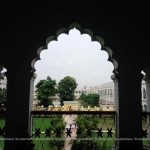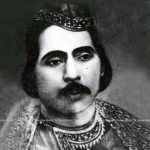Asit Kumar Haldar
Contribution of Lucknow in Art World

Asit Kumar Haldar
Haldar was born in Jorasanko, Kolkata in 1890 and is son of Raveendra Naath Thakur’s niece, to see his mind struck in art from his childhood his father and grandfather sent him to Art and Craft college of Kolkata in the pupil ship of Raveendra Nath Thakur for art education. Haldar learned sculpting from two famous Bengali artists in 1905: Jadu Pal and Bakkeswar Pal, not only this he also learned from Leonard Jennings. At the same time Raveendra Nath Thakur had done with the development of Bengal wash art methodology for resurrection of Indian conventional art and in this expedition with his primary students-Nandlal Basu, Chitindra Naath Ganguly, Haldar was also involved. The art movement of Rabindranath Tagore succeeded to a great extent because of the assistance rendered by Asit Kumar Haldar, Nandlal Bose and Surendra Nath Ganguli. Haldar, however, distinguished himself from the rest, in his styles and themes, which was indeed unique in comparison to his other colleagues.
As he was the part of Art agitation based on sentience, he created more paintings on epos, legends and also on the stately events of Indian history. In count of them he prepared a set of 30 paintings in which ‘Chandragupt Ka Darbaar’, Demetrious Ka Samarpan’, ‘Raja Ranjeet Singh’, Raani Padmini ka jauhar are his paintings. In the Tempera methodology, plane sparkle colors and reinforce lines they are established as most excellent pictures. He was one of the major artists of the Bengal renaissance.
While Haldar copied ‘Jogimeera and Bagh fresco and Ajanta during 1909-11, but they were not bounded with an individual methodology. They worked in all modes including mural pictures, wash method, water color, pencil, paint brush, graphs and more, he illustrated fresco of ‘Jagai-Madhai, and Nityanand and Bhawan Nirmata Akabar in Art and Craft college of Lucknow. With these methods he used many other new techniques in his art. He developed ‘laksit’ technique with the use of laakh on wood.
From his early childhood he was interested in poetry writing including arts. By this mean, in his art, the concepts and enunciations were poetical because of being poetic; mellowness was shown in his faces of arts and crafts. The example of his presumption is as ‘Apsara, Veena, Raas-leela, Parwati ki tapasya, and Kamal dal art. Inspired by this, he composed ‘Sarva vyapi roop, Makhi ki drishti mein sansar and his imagination is shown in height of sky as ‘VISHVAROOP GEETA’, ‘COSMOS MANUFACTURING PROCESS’ as well.
As the principle and an Art Teacher he knew the talent identification and insights, by this in his time he invited HIRANYAMAY CHAUDHARY from Kolkata, BISHESHWAR SEN from Patna and SHRIDHAR MAHAPATRA in this art college, they all became chief column of the college.

Haldar’s talent had no limit, his talent was well known not only in India but also in the foreign countries. And this is the only reason that the British government appointed Haldar the principal of the Government School of Art & Crafts at Lucknow. Haldar was the first Indian to be appointed as a principle of the art college of Lucknow. Asit Kumar Haldar occupied his position until he was superannuated at 55 in 1945. He also buried the flags in London of his talent and honored with the fellow of ROYAL SOCIETY OF ART, LONDON. Not only this, A ‘Haldar Hall’ containing a large collection of his paintings was opened at the Allahabad Museum. Wherever you want to see the talent, you would definitely find Haldar as the great Artist. In every field he contributed his talent as Art, poetry writing and more. In poetry he was an established poet throughout his life. He translated many of poetries and writings into Bengali as Kalidasa’s Meghdoota and Ritusmhara. He also illustrated unconscionable poems in visual art, including twelve from Omar Khayam. He is also writer of many books in Bengali. He remained a budding poet through out his life. In his book Ravitirthe, he has acknowledged his debt to Rabindranath Tagore and Shantiniketan in helping to establish him as an artist.
He squelched every one by his masterpieces.
- Krishna and Yashoda
- Kunal and Ashoka
- Raslila
- The flame of music
- Awaking of mother India
- Rai-Raja Lotus etc.
Nobel Laureate, Rabindranath Tagore, one day said of the late Asit Kumar Haldar’s sculptures, “It is freedom when your spirit conjures up a vision from the inert, to illuminate its every line with the flame of your devotion. You have the magic of life’s touch in your eyes and your dream has come out in a creation in which are made one, my form and your delight”.
Haldar praised old crafts and designs of Madhya Pradesh. He made their work in everyday household use. His effort was to try to infuse a sense of aesthetes among house owners that they should appreciate beautiful things around in their homes, which were of practical use. He was stern in his mission and was well accredited by Uttar Pradesh Government and assorted institutions. He was also creditworthy for designing fine arts courses in the university Allahabad, Banaras, Agra, Jaipur and so on. Even after retirement he kept abreast of his interest in handicrafts by having the rulership of the ALL INDIA HANDICRAFTS board at Bangalore in 1957 where he helped to revive antediluvian handicrafts of Karnataka, which are very popular today all over the country and abroad. Haldar’s art can be seen at Boston Museum, National art gallery in Moscow, Rega Museum in USSR, National Art Gallery New Delhi, Travancore museum in Thiruvananthapuram, Lahore Museum Pakistan etc. Haldar helped people without expecting anything from them. He helped many artists in his epoch and some of them made a history page also.
Haldar broke his breath down because of a heart complaint in Lucknow on 12th of February 1976 in 74th year of his life, leaving a nullity in art world, which would be very difficult to replete. But the aura of Haldar will always alive in the Art world and many of artist commemorate him by his incredible work in Art and Craft.
Aman Deep Singh
(Published in The Lucknow Observer, Volume 2 Issue 19, 5th October 2015)




